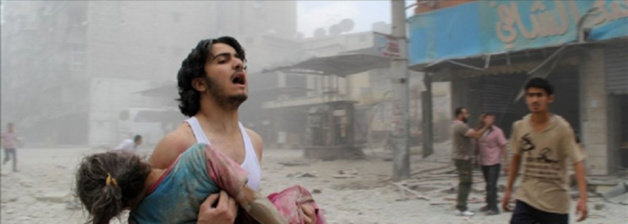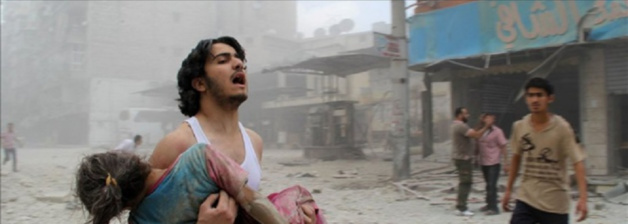
Credit Baraa al-Halibi
Back in 2011, when revolts started in Syria, Baraa did not intend to become a photographer. He was in first year of computer engineering at the University of Aleppo and, according to academic logic, he was aiming to become an engineer. Using his cell phone, Baraa recorded photographs and videos of the historical moments he went through. When the Revolution broke out, he decided to drop out of school to commit himself entirely to the events happening in his country. He wanted to play a part in the Revolution. In order to make his fight more significant and in a view to be as accurate as possible when describing what happened, Baraa started to show precisely what the Syrian media were actively hiding, i.e. violence, civil fights and fear, everywhere. His skills in computer engineering soon became helpful for his task: using a software named Bambuser, he and his compatriots were able to broadcast live videos of demonstrations and gatherings on international channels such as Al-Jazira Live.
Swimming against the tide
His commitment has had many consequences since then: on June the 22nd in 2011, more than three hundred students of the University of Aleppo were arrested by order of Bashar al-Assad, on the grounds that they had taken part in demonstrations – and Baraa was one of them. They were all accused of committing sabotage and insulting the president. Baraa, however, was lucky enough to spend only one month in prison. When he got out, he took the name al-Halibi, “the Aleppine”, and started visiting the rebel districts of Aleppo. In 2013, he bought a second-hand video camcorder. In 2014, he purchased his first camera, a Canon 1100. He then endeavored to learn photographic technique on the Internet, by watching war photographs on the New York Times or the Independent websites. All of those hours spent in analyzing image structure eventually paid off, a few months later.
Then it all went very fast. A friend of his told the AFP about him, and the AFP got in touch with Baraa and bought his photographs. The one who got him the Fujaïrah Prize has a story of its own. He took it on June the 3rd 2014, on Presidential Election day. As he was walking into Soukkari district, the smoke of an explosion in a mosque created a thick fog. A young man, carrying his sister in his arms, was calling for help. That very scene, immortalized by Baraa, became a poignant icon of the sufferings of Syrians under Bashar al-Assad's regime, a daily pain that people must escape if they want to survive. Baraa does not wish to go to France as a refugee, but he means to stay as long as possible in Syria, although it has recently been classified as the most dangerous country in the world.
Keeping in mind the true meaning of the Revolution
When he was in Paris to receive the award, he made it clear in his speech that the terror of the Syrian regime was only showed on pictures, and insisted that in such cases where a whole people suffers from a dictatorship, the need for help is constant. His only wish is to continue the revolution: he has watched it from the start and it is still active today. He is now a freelance reporter for AFP. The picture that received the prize was exhibited until October the 11th, along with many other photographs by other laureates, at the Arab World Institute in Paris. In his speech, Baraa insisted on dedicating the prize to Syrians who took part in the Revolution, as if to remind the world that it is not short-lived, and it is still going on.




























